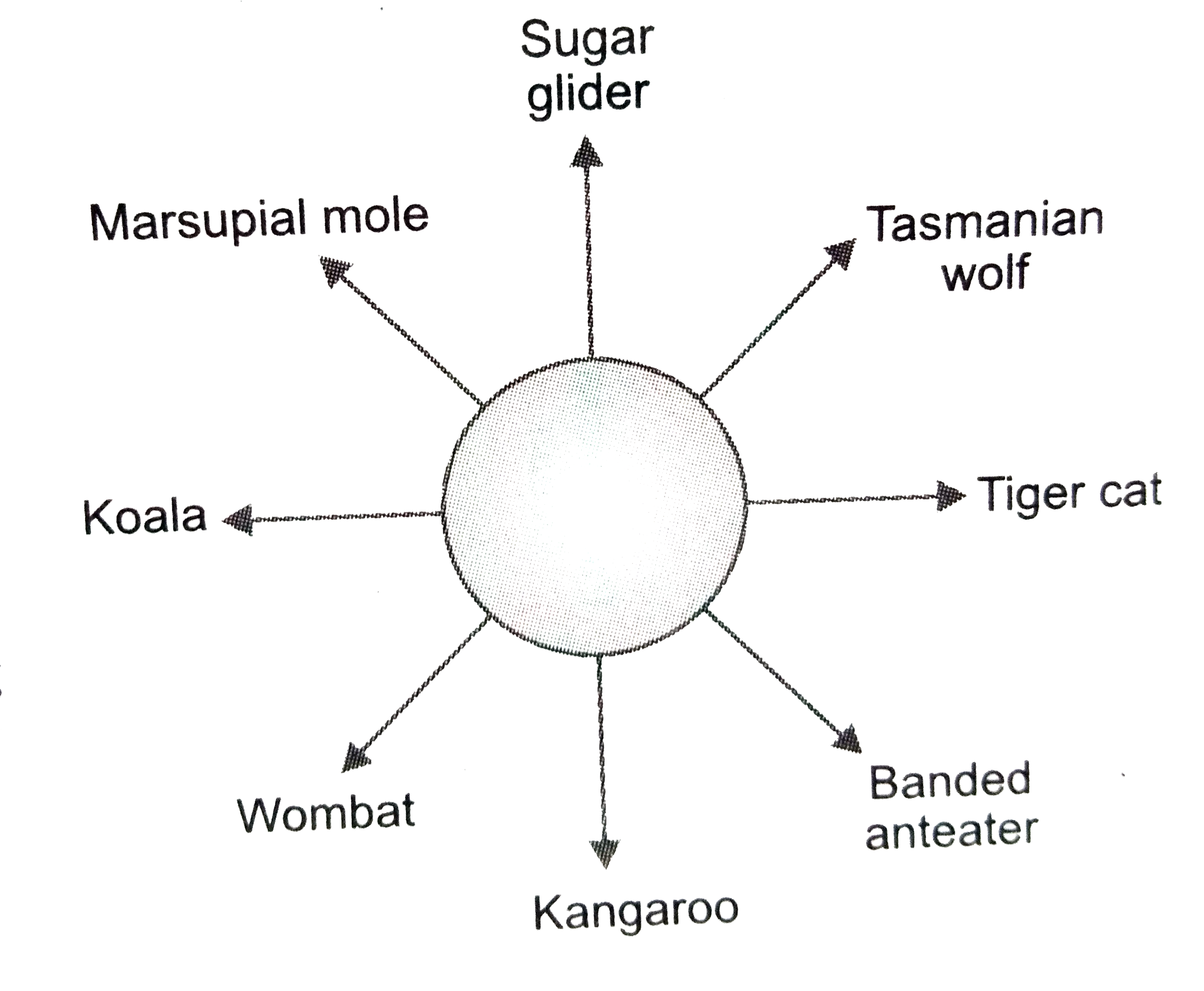Study the figures below and answer the following :
(a)Mention the specific geographical region where these organisms are found.
(b)Name and explain the phenomenon that has resulted in the evolution of such diverse species in the region.
(c )Explain giving reasons the existance of placental wolf and Tasmanian wolf sharing the same habitat.

(a) The figure represents the adaptive radiation in Australian marsupials (b) The marsupials which evolved in North America first migrated to South America and then at the time of separation they were left in newly formed Australia. In Australia marsupials were present only with protherian mammals hence. didn't have much competition to exhibit divergent evolution. (c) Tasmanian wolf and placental wolf shows resemblance with the placental mammals hence, show convergent evolution
Topper's Solved these Questions
- GENETICS AND EVOLUTION BOOK - TRUEMEN BIOLOGY ENGLISHCHAPTER - GENETICS AND EVOLUTION EXERCISE - SECTION-D
25 Videos
- GENETICS AND EVOLUTION BOOK - TRUEMEN BIOLOGY ENGLISHCHAPTER - GENETICS AND EVOLUTION EXERCISE - SECTION-B
38 Videos
- GeneticsBOOK - TRUEMEN BIOLOGY ENGLISHCHAPTER - GeneticsEXERCISE - ASSERTION AND REASON
122 Videos
- HUMAN HEALTH AND DISEASEBOOK - TRUEMEN BIOLOGY ENGLISHCHAPTER - HUMAN HEALTH AND DISEASEEXERCISE - MULTIPLE CHOICE QUESTIONS
209 Videos
Similar Questions
Explain giving reasons the existence of Placental wolf and Tasmanian wolf sharing the same habitat.

View SolutionMention the specific geographical region where these organisms are found.
Name and explain the phenomenon that has resulted in the evolution of such diverse species in the region.
Explain giving reason the existence of placental wolf and Tasmania wolf sharing the same habitat.
View SolutionGive reasons
Placental wolf and Tasmanian wolf exist-sharing the same habitat.
View SolutionStudy the figure given below and answer the questions that follow :
(a)Name the stage of human embryo the figure represents.
(b)Identify 'A' in the figure and mention its function .
( c )Mention the fate of the inner cell mass after implantation in the uterus .

(d)Where are the stem cells located in this embryo ?
View SolutionGiven below is the diagram of a human ovum surrounded by a few sperms. Study the diagram and answer the following questions :

(a) Which one of the sperms would reach the ovum earlier ?
(b) Identify 'D' and 'E'. Mention the role of 'E'.
(c ) Mention what helps the entry of sperm into the ovum and write the changes occuring in the ovum during the process.
(d) Name the specific region in the female reproductive system where the event represented in the diagram takes place.
View SolutionStudy a part of the life cycle of malarial parasite given below. Answer the questions that follows: (a) Mention the roles of 'A' in the life cycle of the malarial parasite.
(b) Name the event 'C' and the organ where this event occurs .
(c) Identify the organ 'B' and name the cells being released from it.

View SolutionStudy the diagrammatic representation of S.L. Miller's experiment given below and answer the questions that follow: (a) How did S.L. Miller create the conditions which existed before the origin of any life on Earth (b) Name the organic compound formed and collected at the end of his experiment. (c)Mention the kind of evolution is experiment supports

View SolutionStudy the diagrammatic representation of S.L. Miller's experiment given below and answer the questions that follow: (a) How did S.L. Miller create the conditions which existed before the origin of any life on Earth (b) Name the organic compound formed and collected at the end of his experiment. (c)Mention the kind of evolution is experiment supports

View SolutionThe diagram given below represents two reproductive cells A and B. Study the same and then answer the questions that follow:

(i) Identify the reproductive cells A and B.
(ii) Name the specific part of the reproductive system where the above cells are produced
(iii) Where in the female reproductive system do these cells unite ?
(iv) Name the main hormones secreted by the (1) ovary (2) testes.
(v) Name an accessory gland found in the male reproductive system and state the function of its secretion.
View SolutionGiven below are two stages in the evolution of man. Study them and answer the questions that follow :

(i) Identify Australopithecus and Neanderthal man from the above pictures.
(ii) Mention two characteristic features each for the two stages.
(iii) Who proposed the theory of Natural Selection?
(iv) Name the organism used as an example to explain 'Industrial Melanisum'.
(v) Give two examples of Vestigial organs in humans.
View Solution
